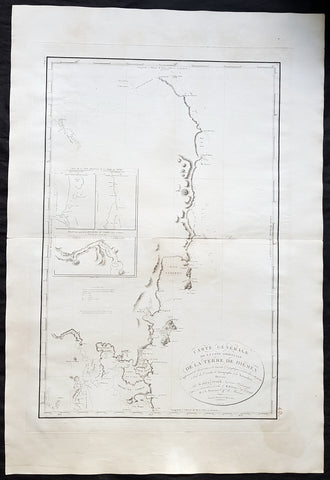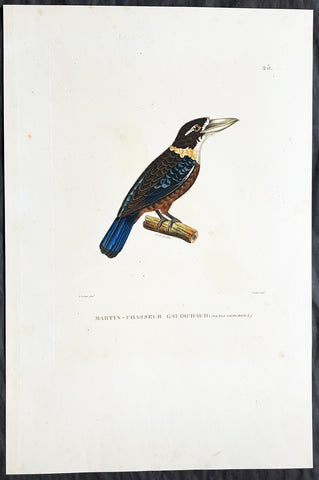
Louis de Freycinet (1779 – 1841)
Background:
He was born at Montélimar, Drôme. Louis-Claude de Saulces de Freycinet was his full name (many calling him Louis de Freycinet). He had three brothers, Louis-Henri de Saulces de Freycinet, André-Charles de Saulces de Freycinet and the youngest, Frédéric-Casimir de Saulces de Freycinet (father of Charles de Freycinet). Louis-Claude was the second oldest. In 1793 he entered the French navy. After taking part in several engagements against the British, he joined in 1800, along with his brother (Louis-Henri de Freycinet (1777–1840), who afterwards rose to the rank of admiral), an expedition to explore the south and south-west coasts of Australia. It set out under Nicolas Baudin in the ships Naturaliste and Géographe. Much of the ground already gone over by Matthew Flinders was revisited, and new names imposed by this expedition, which claimed credit for discoveries really made by the English navigator. In the end, Baudin and Freycinet managed to have their map of the Australian coastline published in 1811, three years before Flinders published his.
An inlet on the coast of Western Australia is called Freycinet Estuary. Cape Freycinet between Cape Leeuwin and Cape Naturaliste and the Freycinet Peninsula with Freycinet National Park in Tasmania also bear the explorer's name.
In 1805, he returned to Paris, and was entrusted by the government with the work of preparing the maps and plans of the expedition. He also completed the narrative, and the whole work appeared under the title of Voyage de découvertes aux terres australes (Paris, 1807–1816).années 1817, 1818, 1819 et 1820, in 13 quarto volumes and 4 folio volumes of plates and maps.
In 1817, he commanded the Uranie, in which the marine hydrologist Louis Isidore Duperrey, the artist Jacques Arago, his junior draughtsman Adrien Taunay the Younger, and others, with a guard of seventeen officers, sailed to Rio de Janeiro, to take a series of pendulum measurements as well as a larger scheme for obtaining observations, not only in geography and ethnology, but in astronomy, terrestrial magnetism, and meteorology, and for the collection of specimens in natural history. Freycinet also managed to sneak his wife Rose de Freycinet aboard.
For three years, Freycinet cruised about the Pacific, visiting Australia, the Mariana Islands, Hawaiian Islands, and other Pacific islands, South America, and other places, and, notwithstanding the loss of the Uranie on the Falkland Islands during the return voyage, returned to France with fine collections in all departments of natural history, and with voluminous notes and drawings of the countries visited.
The results of this voyage were published under Freycinet's supervision, with the title of Voyage autour du monde fait par ordre du Roi sur les corvettes de S. M. l'Uranie et la Physicienne, pendant les années 1817, 1818, 1819 et 1820, in 13 quarto volumes and 4 folio volumes of plates and maps.
Freycinet was admitted into the French Academy of Sciences in 1825, and was one of the founders of the Paris Geographical Society. He died at the family's château de Freycinet[4] near Saulce-sur-Rhône, Drôme
Louis de Freycinet (2)
1802 Louis de Freycinet Large Antique Map of East Coast of Van Diemens Land, Tasmania - Rare
- Title : Carte Generale de la Cote Orientale de la Terre de Diemen...1802
- Size: 38in x 26in (965mm x 600mm)
- Condition: (A+) Fine Condition
- Ref: 92634
- Date : 1802
Description:
This large beautifully engraved early important original antique map of Tasmania as surveyed by the Baudin expedition in 1802 - from Cape Portland to Maingon Bay - was engraved by Charles Bouclet in 1802 - the date is engraved in the title cartouche - and was published in the 1812 Ist edition of Voyage de descouvertes aux Terres Australes by Louis de Freycinet. This was the largest and most detailed map of Tasmania published up to this time.
Background:
The map contains 3 inset maps two of which shows early cartographic details of Van Diemens land by Abel Tasman in 1642 & the English explorer Tobias Furneaux in 1773. The third inset is a map of part of the North River surveyed by Freycinet in 1802.
After returning from the first expedition on Le Naturaliste and Le Geographe Louis Freycinet returned to Australia on La Casuarina and aided by Boullanger explored Northern Tasmania and the southern coast of Australia. This and earlier voyages resulted in the publication of Voyage de descouvertes aux Terres Australes in 1812. (Ref: Tooley; M&B)
General Description:
Paper thickness and quality: - Heavy and stable
Paper color: - off white
Age of map color: -
Colors used: -
General color appearance: -
Paper size: - 38in x 26in (965mm x 600mm)
Plate size: - 31 1/2in x 21 1/2in (800mm x 545mm)
Margins: - Min 2in (50mm)
Imperfections:
Margins: - Light age toning, repair to top margin
Plate area: - Light age toning
Verso: - Light age toning
1824 Louis Freycinet & Paul-Louis Oudart Antique Print Rufous-Bellied Kookaburra
- Title : Martin-Chasseur Gaudichaud: (Dacelo Gaudichaud. N.)
- Ref #: 31741
- Size: 18in x 12in (460mm x 305mm)
- Date : 1824
- Condition: (A+) Fine Condition
Description:
This magnificent large hand coloured original copper-plate engraved antique print of The Rufous-Bellied Kookaburra of Australia & Papua New Guinea (Plate no. 25) by Paul-Louis Oudart (visited by Louis Freycinet in late 1818) was engraved by Jean-Louis-Denis Coutant (1776-1831) and published in the 1824 1st edition of Louis De Freycinets Atlas of Mammals, Birds etc Voyage autour du monde fait par ordre du Roi sur les corvettes de S. M. l\'Uranie et la Physicienne, pendant les années 1817, 1818, 1819 et 1820
These magnificent large hand coloured 1st edition engravings are extremely scarce and a must for ny collection.
The Rufous-Bellied Kookaburra (Dacelo gaudichaud), originally known as Gaudichauds kookaburra after the French botanist Charles Gaudichaud-Beaupré, is a species of kookaburra which is widely distributed through the forests of lowland New Guinea. It has also been recorded on Saibai Island, Queensland, Australia.
General Definitions:
Paper thickness and quality: - Heavy and stable
Paper color : - off white
Age of map color: - Original
Colors used: - Yellow, green, blue, pink
General color appearance: - Authentic
Paper size: - 18in x 12in (460mm x 305mm)
Plate size: - 13in x 9 ½in (330mm x 240mm)
Margins: - Min 2in (50mm)
Imperfections:
Margins: - Light soiling & spotting
Plate area: - None
Verso: - Light soiling & spotting
Background:
After the Restoration the French government gave Freycinet, then a captain, command of another expedition to circumnavigate the globe and conduct research into the shape of the earth, meteorology and terrestrial magnetism. He sailed from Toulon on 17 September 1817 in L Uranie with his wife Rose who secreted herself aboard, and who wrote a separate account of the voyage. After refreshing at the Cape of Good Hope and Mauritius he landed at Shark Bay, Western Australia on 12 September 1818 where he set up an observatory, thoroughly surveyed the inlets and the coastal districts and removed the plate left by Willem de Vlamingh, which he had found and re-erected in 1801. He then sailed north to Timor. His accounts and description of the landscape and life and customs of that and other islands in the East Indies captivated the attention of people in Europe much more than his Australian reports, and a widespread interest developed in the expedition. Leaving Timor on 27 November he sailed via the Moluccas, the Carolines, the Marianas, and the Sandwich Islands and reached Port Jackson on 19 November 1819, the scientists on board adding constantly to their store of information on hydrography, botany, cartography and anthropology. After spending Christmas ashore, they sailed on 26 December and, falling in with the westerlies, set a course for Cape Horn.
On 13 February 1820 L Uranie was wrecked on the Falkland Islands; the scientific records and notes were saved before the vessel foundered, but 2500 of the 4175 plant specimens were lost. Freycinet returned to France in November 1820 and died on 18 August 1842.
There is no evidence in the expedition\'s records or French governmental archives to suggest that there were political objectives in this circumnavigation but, though its purpose was to engage in scientific discovery, this first major voyage undertaken by the restored Bourbons did show the French flag in distant seas and foreshadowed a series of other expeditions which were not wholly scientific.


